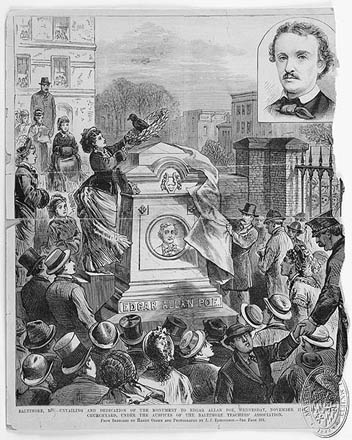Sunday, October 27, 2013
the reburial of Edgar Allan Poe, November 17, 1875
Poe was originally buried without a headstone towards the rear corner of the churchyard near his grandfather, David Poe, Sr. A headstone of white Italian marble, paid for by Poe's cousin Neilson Poe, was destroyed before it reached the grave when a train derailed and plowed through the monument yard where it was being kept. Instead, it was marked with a sand-stone block that read "No. 80". In 1873, Southern poet Paul Hamilton Hayne visited Poe's grave and published a newspaper article describing its poor condition and suggesting a more appropriate monument. Sara Sigourney Rice, a teacher in Baltimore's public schools, took advantage of renewed interest in Poe's grave site and personally solicited for funds. She even had some of her elocution students give public performances to raise money. Many in Baltimore and throughout the United States contributed; the final $650 came from Philadelphia publisher and philanthropist George William Childs. The new monument was designed by architect George A. Frederick and built by Colonel Hugh Sisson, and included a medallion of Poe by artist Adalbert Volck. All three men were from Baltimore. The total cost of the monument, with the medallion, amounted to slightly more than $1,500.
Poe was reburied on October 1, 1875, at a new location close to the front of the church. A celebration was held at the dedication of the new tomb on November 17. His original burial spot was marked with a large stone donated by Orin C. Painter, though it was originally placed in the wrong spot. Attendees included Neilson Poe, who gave a speech and called his cousin "one of the best hearted men that ever lived", as well as Nathan C. Brooks, John Snodgrass, and John Hill Hewitt. Though several leading poets were invited to the ceremony, Walt Whitman was the only one to attend. Alfred Tennyson contributed a poem which was read at the ceremony:
Fate that once denied him,
And envy that once decried him,
And malice that belied him,
Now cenotaph his fame.
Probably unknown to the reburial crew, the headstones on all the graves, previously facing to the east, had been turned to face the West Gate in 1864. The crew digging up Poe's remains had difficulty finding the right body: they first exhumed a 19-year old Maryland militiaman, Philip Mosher, Jr. When they correctly located Poe, they opened his coffin and one witness noted: "The skull was in excellent condition—the shape of the forehead, one of Poe's striking features, was easily discerned."
A few years later, the remains of Poe's wife, Virginia, were moved to this spot as well. In 1875, the cemetery in which she lay was destroyed, and she had no kin to claim her remains. William Gill, an early Poe biographer, gathered her bones and stored them in a box he hid under his bed. Virginia's remains were finally buried with her husband's on January 19, 1885, the 76th anniversary of her husband's birth and nearly 10 years after his present monument was erected. George W. Spence, the man who served as sexton during Poe's original burial as well as his exhumation and reburial, attended the rites that brought his body to rest with Virginia and Virginia's mother, Maria Clemm.
(source)

